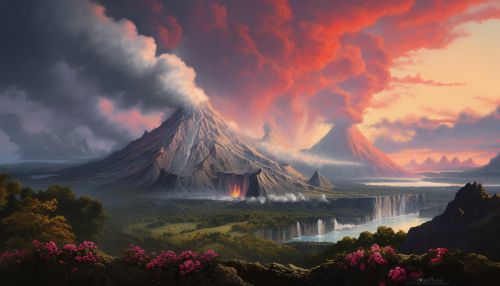Volcanic Eruptions
Introduction
A volcanic eruption is a geological event marked by the expulsion of molten rock, or magma, from a volcano onto the Earth's surface. The magma, which forms in the Earth's mantle, rises through the crust, causing a series of physical and chemical reactions that result in an eruption. Volcanic eruptions are among the most powerful and destructive natural phenomena, capable of causing widespread damage and loss of life.


Types of Volcanic Eruptions
Volcanic eruptions can be classified into several types, based on the nature of the eruption and the type of volcanic material expelled.
Effusive Eruptions
Effusive eruptions are characterized by the outpouring of lava onto the ground. The lava, having low viscosity, flows easily across the landscape. These eruptions are typically not explosive and pose less danger to human life, although they can cause significant property damage.
Explosive Eruptions
Explosive eruptions are characterized by violent explosions that can eject large amounts of ash, gas, and rock fragments into the atmosphere. These eruptions occur when the pressure of gas and magma becomes too great, causing the magma to explode from the volcano.
Causes of Volcanic Eruptions
Volcanic eruptions are primarily caused by the movement and interaction of tectonic plates. The Earth's crust is divided into several large and small plates that float on the semi-fluid layer of the mantle. When these plates move, they can cause magma to form and rise to the surface, resulting in a volcanic eruption.
Plate Tectonics
Plate tectonics is the scientific theory explaining the movement of the Earth's crust. It is widely accepted as the primary mechanism by which volcanoes are formed. Most volcanoes are located along tectonic plate boundaries, where the Earth's crust is most active.
Magma Formation and Movement
Magma is formed when the Earth's mantle melts. This can occur due to the addition of heat, the release of pressure, or the addition of water. Once formed, magma rises through the crust because it is less dense than the surrounding rock. When the magma reaches the surface, it can cause a volcanic eruption.
Effects of Volcanic Eruptions
Volcanic eruptions can have both positive and negative effects on the environment and human societies.
Environmental Effects
Volcanic eruptions can significantly alter the landscape and the environment. They can create new landforms, such as volcanic islands and lava fields. They can also release large amounts of ash and gas into the atmosphere, which can affect climate and weather patterns.
Societal Effects
Volcanic eruptions can have devastating effects on human societies. They can cause loss of life and property, disrupt transportation and communication systems, and lead to economic hardship. However, they can also create fertile soils that are beneficial for agriculture.
Prediction and Monitoring of Volcanic Eruptions
Predicting volcanic eruptions is a complex task that involves monitoring a variety of geological and geophysical signals. Scientists use a range of instruments and techniques to monitor volcanoes and detect signs of potential eruptions.
Seismic Activity
Increased seismic activity is often a sign that a volcano may be about to erupt. Scientists monitor seismic activity using seismographs, which can detect and record earthquakes and tremors.
Gas Emissions
Changes in the types and amounts of gases emitted by a volcano can also indicate an impending eruption. Scientists use a variety of instruments to measure gas emissions, including gas chromatographs and spectrometers.
Conclusion
Volcanic eruptions are powerful natural events that can have significant impacts on the environment and human societies. Understanding the causes and effects of volcanic eruptions, as well as the methods used to predict and monitor them, is crucial for mitigating their potential harm.
